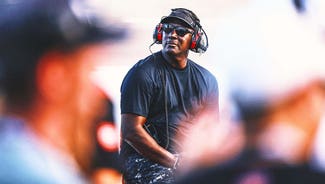
NASCAR to test Charlotte with an eye towards improved competition
As has been the case so often this year at 1.5-mile circuits, track position was everything in Sunday’s Hollywood Casino 400 NASCAR Sprint Cup race at Kansas Speedway.
When he was out in front of the pack, Kevin Harvick’s No. 29 Richard Childress Racing Chevrolet was the clear class of the field and virtually untouchable. When pit-stop strategy dropped him mid-pack, Harvick got stuck and could go nowhere.
“It was like driving two different cars,” said Harvick, who eventually cycled back to the front to score a big victory and remain in championship contention. “Out front it was not even close, and in traffic you were just another one of the cars and had a lot of trouble.”
Harvick wasn’t alone in that sentiment.
The further back drivers get in the field, particularly at the longer and faster tracks, the worse the cars race because of what drivers call dirty air — the swirling currents caused by 43 cars running at speeds of 180 miles per hour or more.
“When you're stuck between 8th and 14th, it's like everybody is back there with machetes and everybody is just whacking and hacking,” said Kurt Busch, Sunday’s second-place finisher. “And once you can clear that, then it's not smooth sailing, but then you seem like you're in a little bit more of the clear.”
Fourth-place finisher Joey Logano said he was stuck where he was, too. “I feel like if you put it in the lead it was going to win the race but if you put it fourth it was going to finish fourth,” Logano said of his Penske Racing Ford. “It was hard to pass cars.”
And Kansas was hardly a new phenomenon. Pit road and race restarts are the two places the overwhelming majority of race-winning passes have been made this year on 1.5-mile tracks.
At Las Vegas, Texas, Kentucky and Atlanta, the race-winning pass was made on pit road during pit stops. At Charlotte and Chicagoland, it was made on the restart after a caution period. And in the first Kansas race, the final pass for the lead occurred when the leader pitted under green and then a caution flew.
Once somebody gets the lead, they are very hard to pass under green-flag conditions. The lead car has clean air on the nose, which gives it more downforce and allows it to turn better. The closer the second-place car gets to the leader, the less air he has on his nose, which is why you often see a driver pull up to the leader only to be unable to pass him.
Even at the shorter and slower one-mile Dover track a week prior to the second Kansas race, Dale Earnhardt Jr. came off pit road with four fresh tires on the final pit stop, but couldn’t pass teammate Jimmie Johnson who only took two tires but was in the lead. That’s how important clear air is.
The good news is, it’s a problem NASCAR is working hard to fix.
Next Monday at Charlotte Motor Speedway, two days after the Bank of America 500, NASCAR will conduct a test at the 1.5-mile track. The sanctioning body will try a number of changes to the new Generation-6 cars, which debuted earlier this year, with an eye to improving competition for 2014.
NASCAR, the three manufacturers and the teams already have spent countless hours on wind-tunnel testing with the Gen-6 cars, but the best way to improve performance and come up with more competitive racing is by real, on-track testing with multiple cars and teams at speed.
A NASCAR spokesperson said “some of things but not limited to” that will be tested Monday at Charlotte are: “some aerodynamic enhancements to the G-6 cars; chassis ride-height test for minimum racing heights; and drafting scenarios with multiple cars."

